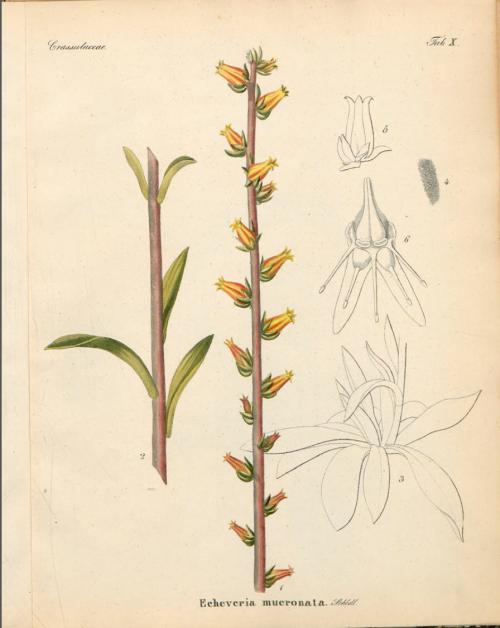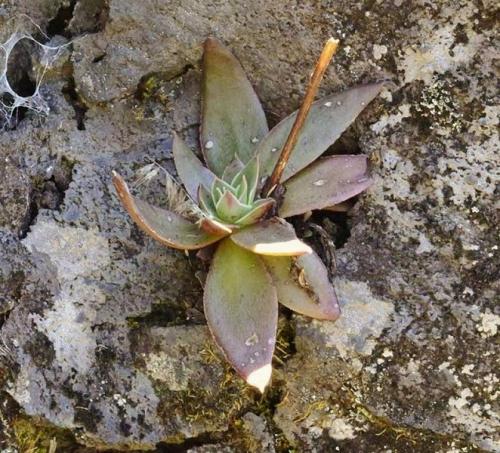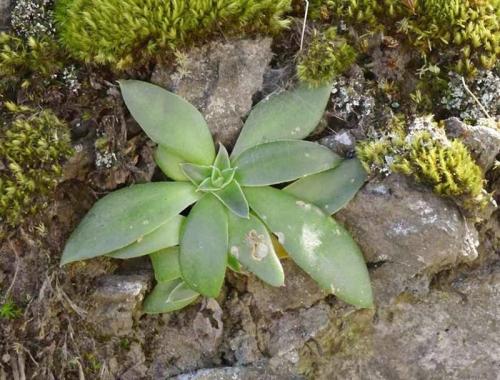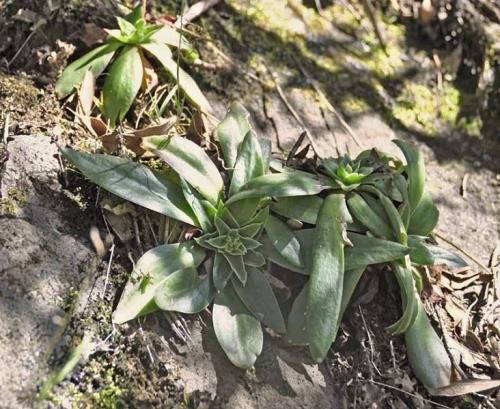MUCRONATA Schlechtendal, 1839
Synonyms :
Cotyledon mucronata (Schlechtendal) Baker (1869)
Echeveria crassicaulis Walther (1935)
Series Mucronatae
Type : Ehrenberg 294. An exact type locality is not known, the protologue indicates that E. mucronata is found growing in mountainous regions of the Mexican state of Hidalgo, like Mineral del Monte, Omitlan, or Cuesta Blanca - Mineral del Monte possibly only the shipping place. (Type is destroyed).
Neotype : Anonymus s.n., Hortus Halensis, plate 10, 1853.
Etymology : For the leaf, sepal and petal tips.
* Distribution : Mexico (Federal Distict, Estado de Mexico, Guanajuato, Guerrero, Hidalgo, Jalisco, Michoacán, Morelos, Nuevo Léon, Oaxaca, Puebla, Querétaro, Tamaulipas, Tlaxcala and Zacatecas) > see below.
First Description by Schlechtendal in Linnaea 13: 411. 1839 :
Glabrous, green, acaulescent
Basal leaves rosulate, lingulate-lanceolate, entire, 7.5 - 10 cm long and to 4 cm wide at the widest part, 2 cm wide at base, leaf margins are somewhat variable, sometimes slightly waved or irregularly toothed or almost denticulate, hard and tough, leaf surfaces are sometimes minutely scabrous (slightly rough to the touch), upper surface lightly flattened - canaliculate, lower surface obsoletely and obtusely carinate.
Flowering stem 30 - 60 cm long, simple, lower part with few smaller leaves, raceme 25 - 30 cm long with 20 - 30 flowers.
Flowers sometimes an inch distant, on upper part sessile or almost so, on lower part with 4.5 mm long pedicels.
Calyx half as long as the corolla.
Corolla 12.5 mm long, more or less intensely red, tips and upper margins yellow, petals narrow, acuminate, acute, spreading at tips, mucro often on the outside of the curved apex; in dried material, because of the dorsal mucros, petal apices seem to be cucullate or almost tridentate, the lateral dents less broad, the middle one mucronate.
Cytology : n = 16, 32.
Note :
1. The First Description is from a plant the exact origin of which is unknown. Way back in the 1830s such plants were found growing in mountainous regions of Hidalgo, like Mineral del Monte or Omitlan or Cuesta Blanca. The illustration in Hortus Halensis, pl. 10, 1853, the neotype (see below), shows a plant with a lax raceme, the single flowers irregularly distant, calyx rather short, flowers distinctly red and yellow and only little open at mouth.
2. E. crassicaulis from Cima, described by Walther as a distinct species, now synonym of E. mucronata, has the same red and yellow flowers and the same type of inflorescence, only the bracts subtending the flowers are much longer, almost as long as the corolla.
3. In view of the extremely elaborate original description by Schlechtendal and the neotype, designated by Walther himself, showing the red flowers with yellow stripes, it is incomprehensible how he could describe a plant quite distant from the type locality and with pure yellow flowers as "E. mucronata" (Echeveria 375-376, 1972). As a matter of course his description is to be ignored and likewise the respective summary by Kimnach in the Illustrated Handbook of Succulent Plants 117, 2003.
More details about E. crassicaulis and E. mucronata can be found on p. 333-336, 339-340 in Revision of Walther's monograph Echeveria, 1972.
4. Accordingly the photos on www.crassulaceae.com and in Pilbeam, The genus Echeveria, 178-179, Fig. 230, 2008, of a purely yellow flowered plant are not correct. While not showing true E. mucronata, they correspond perfectly to Uhl's photo of E. platyphylla, Pilbeam, 210, Fig. 287.
5. * E. mucronata is often confused with E. pinetorum and E. platyphylla, even with E. paniculata. Therefore it is not possible to estimate its distribution range correctly.
6. The ISI offering n° 176, 1958, of Echeveria crassicaulis Walther is of course E. mucronata.

Neotype of Echeveria mucronata, taken from Hortus Halensis, pl. 10, 1853.
Plants in habitat in Michoacan, Mexico / Plantes dans le Michoacan, Mexique :



.jpg)
Photo Ignacio Garcia Ruiz